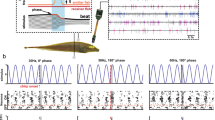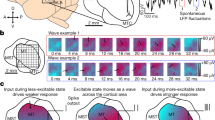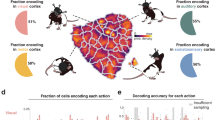Abstract
ANIMALS acquire information about sensory stimuli around them and encode it using an analogue or a pulse-based code. Beha-viourally relevant features need to be extracted from this representation for further processing. In the electrosensory system of weakly electric fish, single P-type electroreceptor afferents accurately encode the time course of random modulations in electric-field amplitude1. We applied a stimulus estimation method2 and a signal-detection method to both P-receptor afferents and their targets, the pyramidal cells in the electrosensory lateral-line lobe. We found that although pyramidal cells do not accurately convey detailed information about the time course of the stimulus, they reliably encode up- and downstrokes of random modulations in electric-field amplitude. The presence of such temporal features is best signalled by short bursts of spikes, probably caused by dendritic processing, rather than by isolated spikes. Furthermore, pyramidal cells outperform P-receptor afferents in signalling the presence of temporal features in the stimulus waveform. We conclude that the sensory neurons are specialized to acquire information accurately with little processing, whereas the following stage extracts behaviourally relevant features, thus performing a nonlinear pattern-recognition task.
This is a preview of subscription content, access via your institution
Access options
Subscription info for Japanese customers
We have a dedicated website for our Japanese customers. Please go to natureasia.com to subscribe to this journal.
Buy this article
- Purchase on SpringerLink
- Instant access to full article PDF
Prices may be subject to local taxes which are calculated during checkout
Similar content being viewed by others
References
Wessel, R., Koch, C. & Gabbiani, F. J. Neurophysiol. 75, 2280–2293 (1996).
Bialek, W., de Ruyter van Steveninck, R. & Warland, D. Science 252, 1854–1857 (1991).
Zakon, H. in Electroreception (eds Bullock, T. H. & Heiligenberg, W.) 103–156 (Wiley, New York, 1986).
Bastian, J. in Electroreception (eds Bullock, T. H. & Heiligenberg, W.) 577–611 (Wiley, New York, 1986).
Hopkins, C. Annu. Rev. Neurosci. 11, 497–535 (1988).
Maler, L., Sas, E. & Rogers, J. J. Comp. Neurol. 195, 87–139 (1981).
Hopkins, C. J. Comp. Physiol. A 111, 171–207 (1976).
Bastian, J. & Heilgenberg, W. J. Comp. Physiol. A 136, 135–152 (1980).
Turner, R., Plant, J. & Maler, L. J. Neurophysiol. 76, 2364–2382 (1996).
Heiligenberg, W. Neural Nets in Electric Fish (MIT Press, Cambridge, MA, 1991).
Poor, H. An Introduction to Signal Detection and Estimation (Springer, New York, 1994).
Gabbiani, F. & Koch, C. Neural Computat. 8, 44–66 (1996).
Gabbiani, F. Network: Comp. Neural. Syst. 7, 61–85 (1996).
Lehky, S., Sejnowski, T. & Desimone, R. J. Neurosci. 12, 3568–3581 (1992).
Anderson, T. W. An Introduction to Multivariate Statistical Analysis (Wiley, New York, 1984).
Turner, R. W., Maler, L., Deerinck, T., Levinson, S. R. & Ellisman, M. H. J. Neurosci. 14, 6453–6471 (1994).
Maler, L. & Mugnaini, E. J. Comp. Neurol. 345, 224–252 (1994).
Yuste, R. & Tank, W. Neuron 16, 701–716 (1996).
Bair, W., Koch, C., Newsome, W. & Britten, K. J. Neurosci. 14, 2870–2892 (1994).
Allen, C. & Stevens, C. Proc. Natl Acad. Sci. USA 91, 10380–10383 (1994).
Kawasaki, M., Rose, G. & Heiligenberg, W. Nature 336, 173–176 (1988).
Metzner, W. & Heiligenberg, W. J. Comp. Physiol. A 169, 135–150 (1991).
Metzner, W. J. Neurosci. 13, 1862–1878 (1993).
Maler, L, Sas, E., Johnston, S. & Ellis, W. J. Chem. Neuroanat. 4, 1–38 (1991).
Bastian, J. & Courtright, J. J. Comp. Physiol. A 168, 393–397 (1991).
Carr, C., Maler, L. & Sas, E. J. Comp. Neurol. 211, 139–153 (1982).
Krueger, J. & Becker, J. Trends Neurosci. 14, 282–286 (1991).
Jolliffe, I. Principal Component Analysis (Springer, New York, 1986).
Raudys, S. & Jain, A. IEEE Trans. Patt. Anal. Mach. Intell. 13, 252–264 (1991).
Shumway, C. J. Neurosci. 9, 4388–4399 (1989).
Author information
Authors and Affiliations
Rights and permissions
About this article
Cite this article
Gabbiani, F., Metzner, W., Wessel, R. et al. From stimulus encoding to feature extraction in weakly electric fish. Nature 384, 564–567 (1996). https://doi.org/10.1038/384564a0
Received:
Accepted:
Issue Date:
DOI: https://doi.org/10.1038/384564a0
This article is cited by
-
Neuronal On- and Off-type heterogeneities improve population coding of envelope signals in the presence of stimulus-induced noise
Scientific Reports (2020)
-
Astrocytes integrate and drive action potential firing in inhibitory subnetworks
Nature Communications (2018)
-
Coding of time-dependent stimuli in homogeneous and heterogeneous neural populations
Journal of Computational Neuroscience (2018)
-
Encoding noxious heat by spike bursts of antennal bimodal hygroreceptor (dry) neurons in the carabid Pterostichus oblongopunctatus
Cell and Tissue Research (2017)
-
Distinct predictive performance of Rac1 and Cdc42 in cell migration
Scientific Reports (2015)



